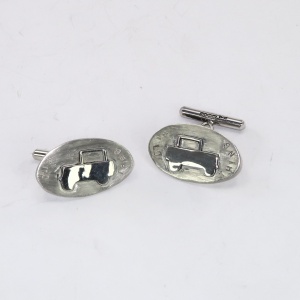
These cufflinks are a gift to the owner of ‘Wild Thing’ – a modified landrover used for off road competitions.
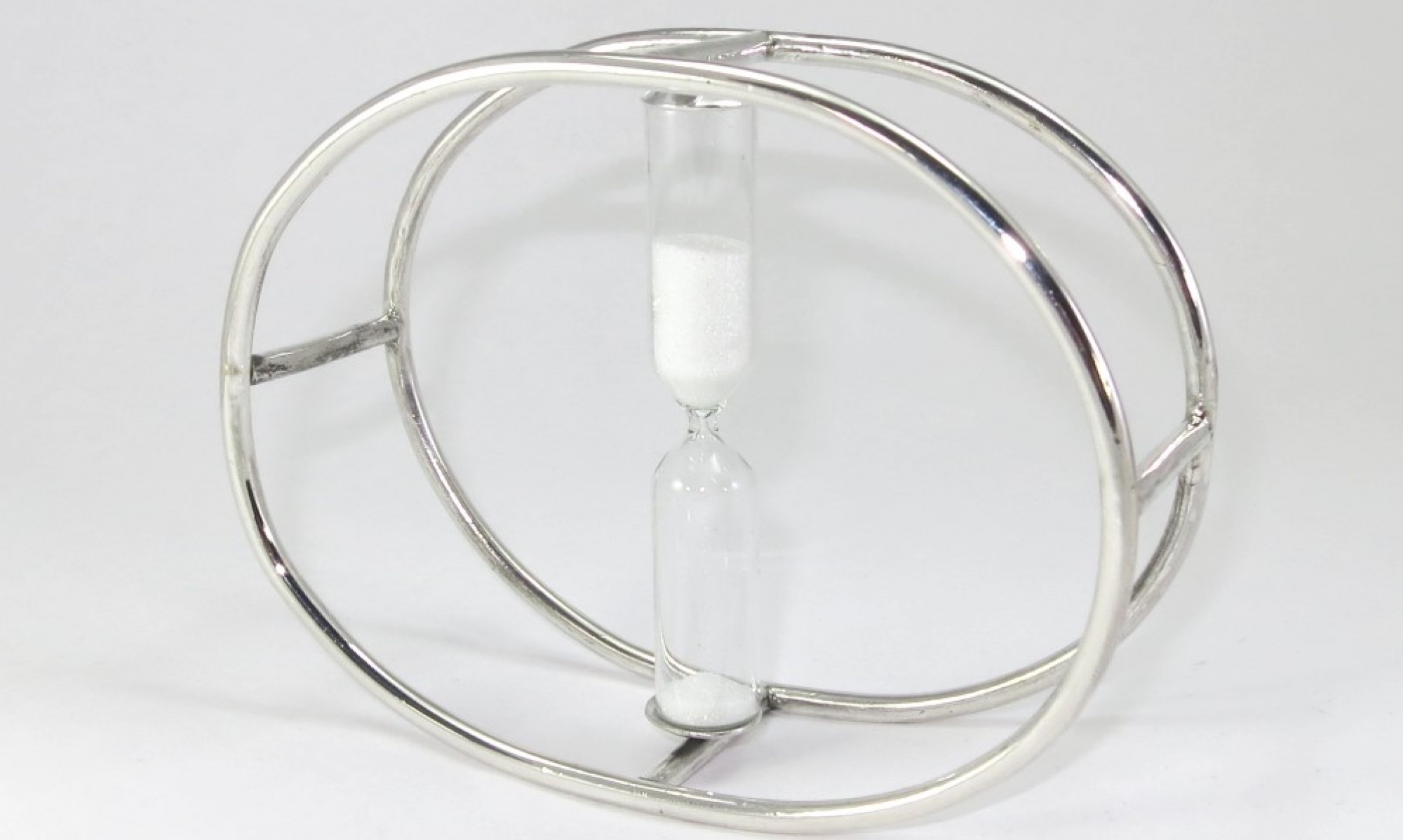
Handmade in Oxfordshire
I’m quite pleased with this repair. There was a similar dint on the opposite side that came out well too. It had been neglected and took a lot to bring the inside back to a shine.
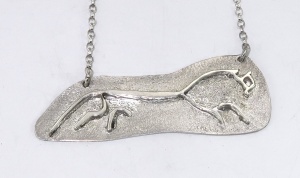
The horse is about 5cm long and at the limit of my skills to cut from silver sheet. For this commission, it was important that the horse was as realistic as possible and so it had to be on a backing as two legs are not connected to the body in reality. Also the mechanical strength of the silver would mean that a freestanding version would be too vulnerable to damage.
Jewellery and other siilverware based on the Uffington White Horse is available in my shop here.
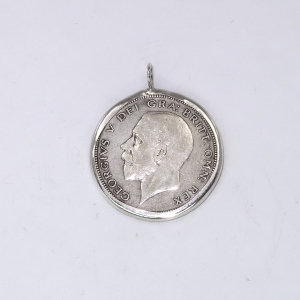
2/6 – half a crown or 12.5d in new(! post 1971) money. This is will make a pendant of interest for someone. It is 50% silver so worth more than face value. The silver band is formed around the coin, so it is very secure, but does not damage the coin in any way so my method is safe for all sizes and value of coin. I have some Roman bronze coins mounted this way in my shop.
It’s the same lantern as the earrings in the post below, but here is one with a clear stone as a pendant. Also from this angle, you can just see the hallmark lasered on the base. The lantern is 12mm across and weighs about 5g.
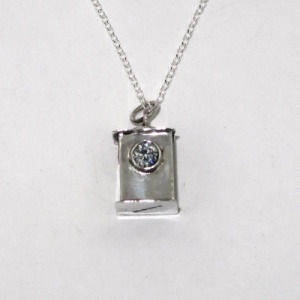
It is available to buy from my shop, or contact me if you want a different stone.
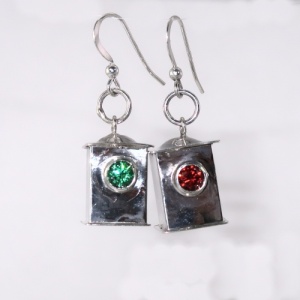
These are a development from a recent commission – I like this design better. It reminds me of a lantern that someone might carry from the large ring. These are fitted with green and garnet cubic zirconia to represent navigation lights, but clear or other colour coould be used instead. The lanterns are hallmarked on the base. These are available from my shop.
Over the years, I’ve cast a range of nuts, fruit stones and seeds – walnuts, acorns, nectarines, dates, pecan….. Olives seeds and hazelnuts in the form of pendants or cufflinks have proved the most popular. I recently did a silver nutmeg and now I have just cast some apricot stones – because I haven’t done it before and ate some fresh apricots!
I’ve cast both whole stones and a half stone that has a chain loop added so that it can be used as a pendant.
The pendant is available from my shop. Should you want a full stone, please contact me.
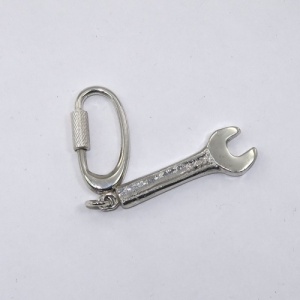
I’ve made a few silver spanners over the years. The first one was in the early 1990s I think. They are cast in one or two cuttlefish bones depending on whether there is a flat side for engraving or not.
Casting always has some failures. In the case one half of the spanner wasn’t good enough, but there’s nothing wrong with the half you can see and I thought a key ring might be a good gift for a mechanic or engineer. You can buy this in my shop.
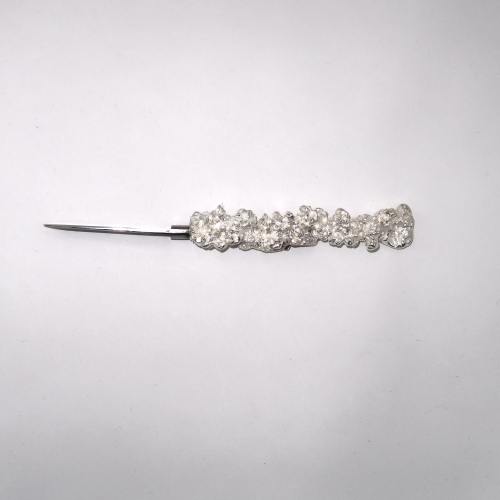
The blade is from an old wooden handled knife of my father. I think it’s a small paring knife – the blade is 5cm long. Whether it is a family heirloom or something he picked up for 5p in a car boot sale I will never know!
I decided to make a silver handle for it. This is a salt casting, with a tube beneath to take the knife tang.
The hallmark on the silver was new to me. I had included the blade when it was sent to the London Assay Office. They chose not to punch the marks as I expected, but lazered them on adding ‘+Metal’ to allow for the iron blade.
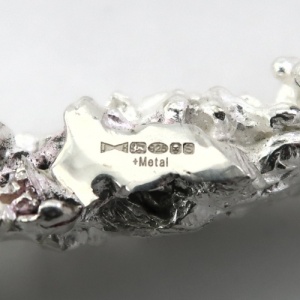
I’ve had stainless steel brooch pins stamped ‘METAL’ before, but never the base metal unscathed and the hallmark done like this. Not that I mind at all – it just wasn’t what I expected.

Today I’ve just launched my new website.
Hopefully everyone will find it easier to use and more up to date. Please let me know if there are any problems or errors.
The shop remains the same – that seems to work fine and ‘it ain’t broke, so why fix it?’, but the new website should surround the shop seamlessly.
It is also a more secure site now, you should see the little padlock on the browser bar most of the time. There are probably a few links I need to fix still. I still have some content I want to move over or update.
I’ve trimmed down the examples of my work to about 100, but there’s more in the shop and on the blog. Also you can sneak into the old website areas for further examples.
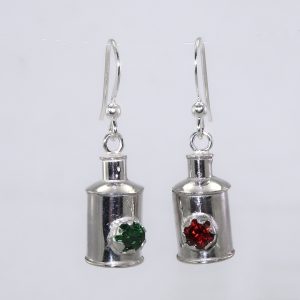
These were a commission for the birthday of the wife of a local boat owner and aimed to replicate the old style oil lantern type lamp. (Port is the on the left when facing the prow of a boat and is the red light.)
A more recent dtyle is available in my shop.
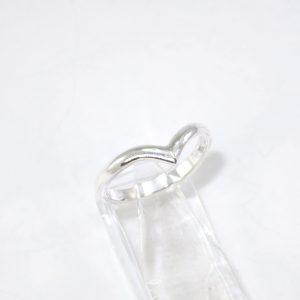
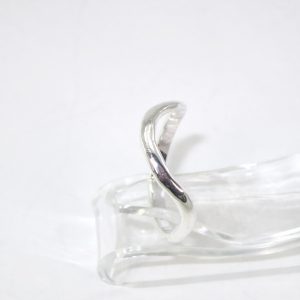
These rings are designed to fit around an engagement ring or other ring with a large stone. They are really example pieces to show what I can make – in silver or gold – but these two are available in my shop.
Nothing too exciting, but I’ve recently updated my page on chains to include a further page with some photos of common styles of chain and clasp.
For example
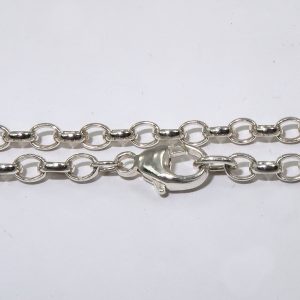
Please remember that if you like a pendant in my shop, I can change the style and length of its chain. Just contact me first, rather than ordering from the shop.
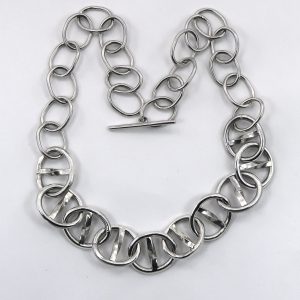
This necklace is a commissioned piece to substitute for one that went missing. The main links are 20 by 25 mm and the whole piece weighs 100g. It has a toggle bar clasp which allows some adjustment of the length to suit different clothes. The bar can go through any of link of the other end of the chain, though it does then get a little asymmetric if it is shortened too much.
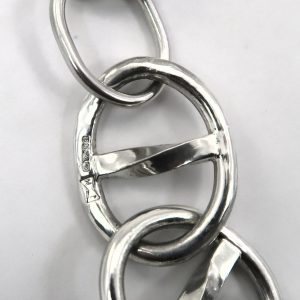
This picture gives a closeup of the links and the assay markings.
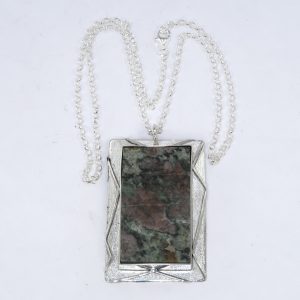
This beautiful slice is an example of eclogite, clearly showing the garnet inclusions. Quoting Wikipedia – ‘Eclogite typically results from high-pressure metamorphism of mafic igneous rock (typically basalt or gabbro) as it plunges into the mantle in a subduction zone’. I was asked by the Department of Earth Sciences at Oxford University, just up the road from me, to create a pendant based on the specimen as a gift for a leaving colleague. The Department has a logo of symbolic mountain ranges, so I decided to reflect that in the border.
The recipient was delighted!
The problem with making an egg timer is how to secure in place the glass vial that actually holds the sand. I came up with a less conventional solution here, but decided to also make a pretty conventional one and this is the result.
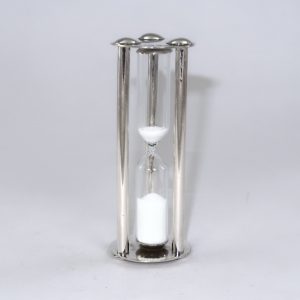
In this case one of the sets of domes are more like push fit rivets that fit into the tubular columns when the glass vial is in place. You need to get the height of the columns just right!
This egg timer is for sale in my shop.
A Beatrix Potter enthusiast saw that I had mounted coins for pendants in the past, including 50p coins. However she wanted two mounted together – one slightly overlapping the other.
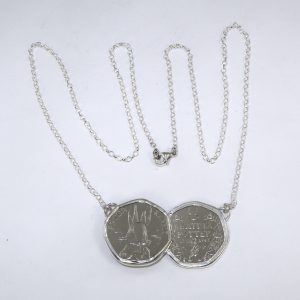
I had to devise a new method of creating the mounts, but the process worked well. In principle, I could mount other coins the same way.
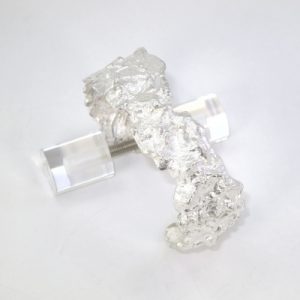
I have two of these in stock at present a smaller one and a larger one. By the process that they are made, each one is unique and they are a statement piece – probably not to be worn every day. Shop
By contrast
These three pendants are good for daily wear. Shop
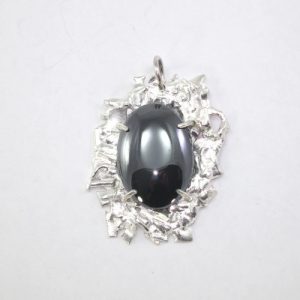
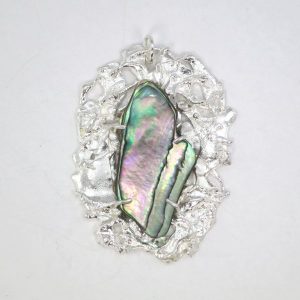
The second of two major commissions this financial year is a silver plough. (The first was the Abingdon Trinity morse).
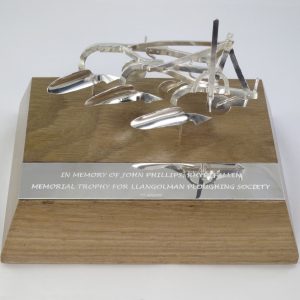
The plough is fully hallmarked and formed from sterling silver sheet and wire section. It weighs about 80 grams on its own and is about 125mm long.
It is modeled on a Ferguson three furrow plough that a friend owns and kindly allowed me to photograph and measure.
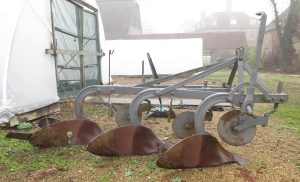
My plough isn’t an exact copy that would be much more time consuming, but you’ll see the resemblance. The trophy will be used as a prize in a ploughing competition.
It proved to be quite a challenge, but I and the purchaser are very pleased with the end result.
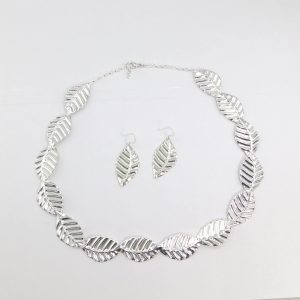
Each leaf is about 36mm by 20mm and has a concealed hinge to allow good flexibility of the necklace around the next. There is a degree of adjustment available by the positioning of the catch on the chain.
Earrings to match of course. The earrings and a brooch are available in my shop.
All pieces are hallmarked – by laser to avoid the marking showing through to the front.
My full sized clothes pegs are a steady selling item, but they are a lot of work, heavy and so expensive. I saw some tiny wooden pegs so I thought I would make some small silver ones.
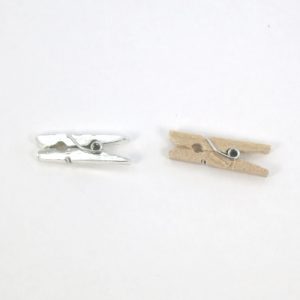
This is the result. They are about 25mm long and weigh just four grams. They use the metal springs from the small wooden clothes pegs as silver wire of that gauge would have no strength at all. These have a fairiy reasonable grip. They can be purchased in my shop.
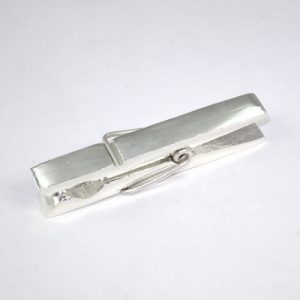
A full sized solid silver clothes peg. It’s about 75mm long and weighs just under 70g and is available from my shop. This is an alternative to the textured version of the peg mentioned here.
I’ve also made some baby pegs in silver too.
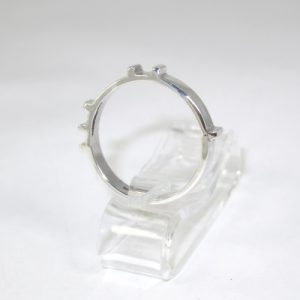
if you need to count repetitive events – for me swimming lengths – then a ring or maybe two like these are essential. They fit on the index finger and are rotated with the thumb. Rotate one ring every two lengths by one quarter of a turn. That gives you an eight length counter. If you have another on the other index finger and rotate that a quarter every time the other does one revolution then you can count to 32. Available from my shop.
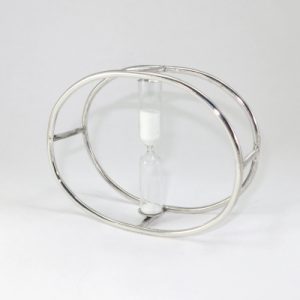
A rather unusual design for an egg timer, but it conveniently solves the problem of how to get the glass vial into the frame. The oval is pulled apart to allow the vial to slip into the domes and so is under very little pressure. This unique piece is available from my shop.
I have also made a more conventional version.
I have a photograph of pretty much everything that I have made. Although I’ve been silversmithing since 1978, I decided in early 2006 to record my work on a database. From that point, each new design or item, if individuals varied from the design, has been allocated a number ss001, ss002 etc, which is used on the corresponding photograph. Each item also has a number.
With the cow horn rings previous to this post, I’ve reached ss1500 so that’s about 150 variants each year. I’ve made 2800 items in that time. Most pictures are on my website, in my shop or in the blog.
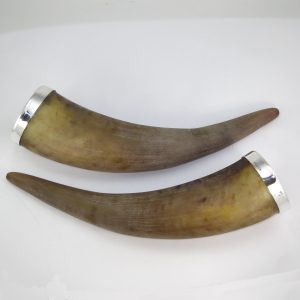
What do you do with a pair of cow horns? Turn them into drinking vessels with smart silver banding of course. I was asked to make these two pieces of silver to make the drinking experience more pleasant. The silver is more than just a ring, but curls over the lip and inside the horn to provide a pleasant experience for ones lips. The rings are fully hallmarked fine silver and the silver has been formed to follow the contours of the horn. inside and out. For security, hygiene and to prevent moisture traps, the rings are bedded in with food safe adhesive/ sealant.
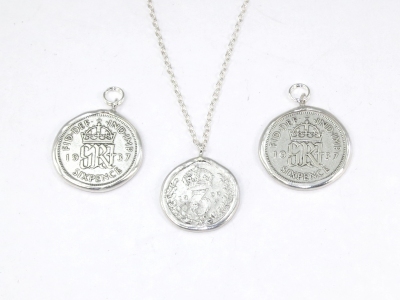
As a change from mounting coins into cufflinks and 50p coins into pendants, I was asked to set two silver sixpences and one silver threepence as you can see above. These will be gifts – the coins having sentimental value. The band is fine silver (99.9%) which is so soft that it can be manually worked over the edge of the coin to give a tight grip.
Always one for a challenge – I was asked to make a sand dollar. What’s a sand dollar you ask – as I did. It’s a form of sea urchin.
This is an example about 5 cm across – about the largest I can cope with. As 10 cm is a more typical size, I can only assume it became deceased prematurely as the markings are not as pronounced as larger specimens. It does , just, show the typical five fold symmetry I find fascinating.
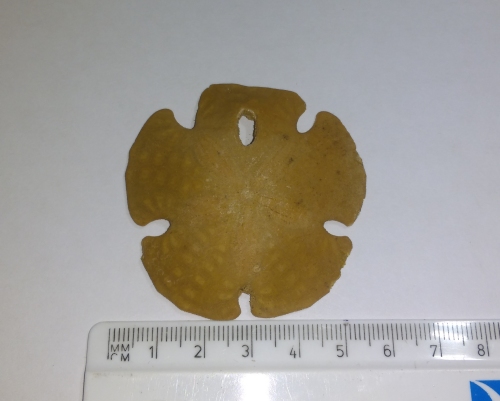
I’ve managed to get quite a good cast of it – pleasingly retaining the detail.
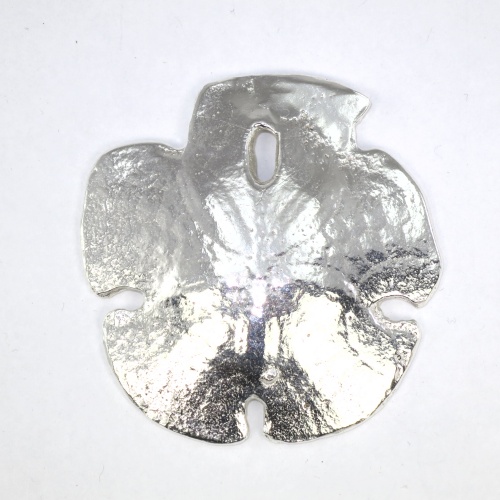
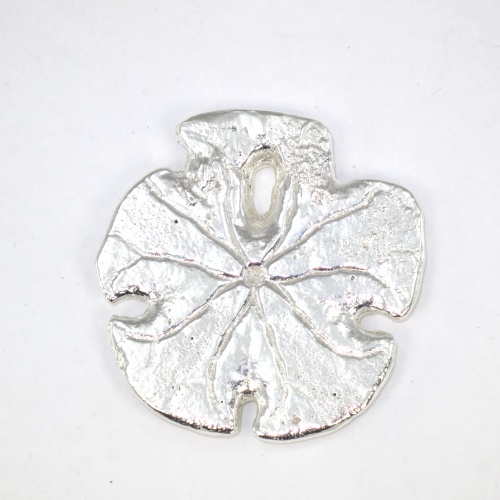
This one is sold, but I’ll be making another – should you be interested!
To complement my bee pendants and brooches, I’ve now created some bee earrings.
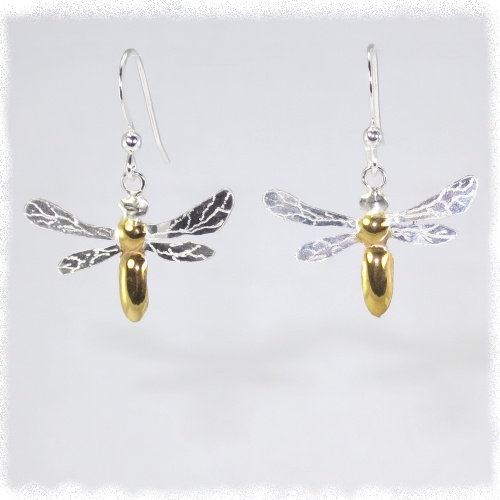
These bees are about 30mm wingtip to wingtip and available with various ear fittings. In the examples shown, the thorax and abdomen are gold-plated. However, the bees could bee plain silver, all gold-plated and maybe even bands on the abdomen. Available from my shop.
The bees themselves are on show here.
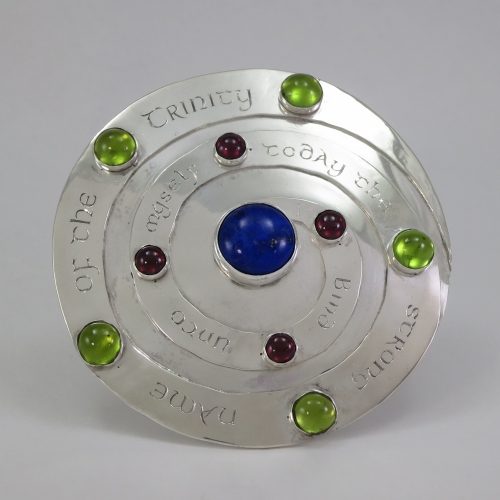
One exciting commission I received was to endeavour to make a morse. (A morse is a large clasp or brooch on the front of an ecclesiastical cope.) The one I made was worn by Bishop Rowan Williams, the former Archbishop of Canterbury, at a service at St Helens Church Abingdon in May. (Photos to follow.) The morse will be recorded in the church terrier (inventory) as part of the church silver. It is 75mm in diameter.
The design incorporates semi- precious stones whose colours would reflect the theology-in- colour of the three angelic visitors in Rubliev’s icon. The Father is betokened by a large stone of lapis lazuli at the centre of the morse; blue is the colour signaling divinity. The Son is betokened by four garnets roughly in the shape of a cross; red signals the blood of sacrifice. Five peridot stones ‘fly’ out toward the edge; light green signals the Spirit, the ‘giver of life’.
The donor expressed the wish that the morse have Celtic Christian features too. So, the morse is round and slightly bowed to recall the Celtic ‘lorica’ or breastplate. The first line of the lorica prayer ascribed to St Patrick himself, I bind unto myself today the strong name of the Trinity, is engraved on the morse following the spiral in which the stones are set.
The life of the Trinity thus spirals out in the act of creation, and draws creation and humankind back to itself in redemption and sanctification.
My thanks to Revd Dr Charles Miller who commissioned the piece and provided the interprettion of the symbolism above.
Years ago my wife and I visited Sam Gimignano in Italy. I bought a box of bright blue tessera – the little tiles used as the basis of a mosaic. I occasionally make some earrings using them that usually sell well.
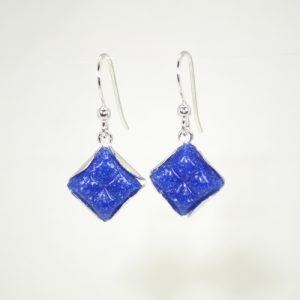
It was only recently that a lady visited my stand during Artweeks and said “I make mosaics and those are tesserae, but that’s the back which is pressed into the cement.”
I’d never given it a moment’s thought – that side looked best so I put it outermost. Of course, the other side being flat sits well in the setting. Few people normally see this side.
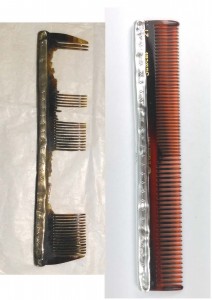
This silver backed comb has sentimental value to the owner and was clearly of no practical use. The problem here is usually to find a suitable replacement. The best fit was slightly too long and had to be filed and repolished and the teeth are shorter than the original., but it is now usable. If anyone else is interested, then please locate a comb that you think is an acceptable replacement and I’ll fit it.
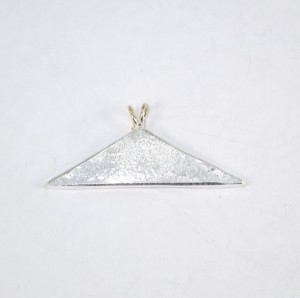
A gift from a geologist to a vulcanologist. The pendant is just under 4cm at the base and takes its shape from Cotopaxi in Ecuador. It has a reticulated surface to provide texture on the slopes. To provide interest, what would normally be a silver ring for the chain has been replaced by two 9ct gold circles to give an impression of an eruption. The hallmarks are punched on the rear.
Another addition to my nuts and seeds collection
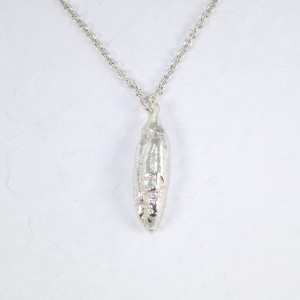
I’m ever surprised at the detail in these seeds.
I wasn’t planning to put this in my on-line shop, but should you want one, then please contact me.
Douglas Adams – the author of ‘The Hitchhiker’s Guide to the Galaxy’ was born on 11 March 1952. He would be coming up to his 64th birthday had he not died in 2001.
I’ve always liked the Hitchhiker ‘trilogy’ and made a pair of these cufflinks for myself
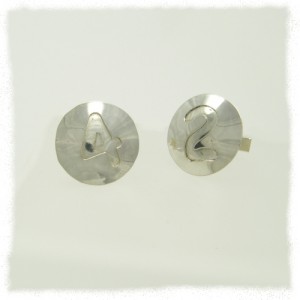
I’ve sold other pairs and there are two types of ’42’ available for sale in my shop. I have also made variants including ’52’ and H2 (for hydrogen – the 2 was subscripted).
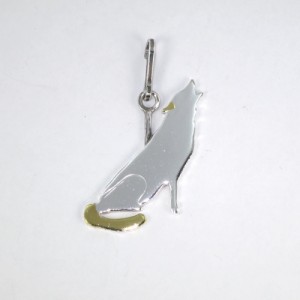
The dog is 45mm tip to tail and 2mm thick with a gold tail and ears. The gold is a development of the animal brooches I have been making.
I don’t do much work with coloured stones – just when a stone or mineral excites my interest, but if my customer wants stones, then stones they shall have.
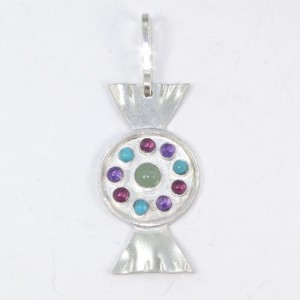
The design is meant to look like a wrapped sweet. Teasing the design a little further, I was assked to gold plate the area around the stones, as you see below.
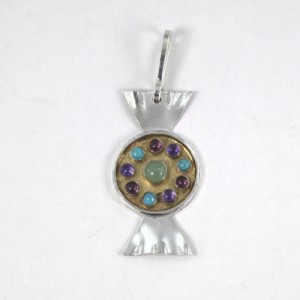
The plating is pen plating and very thin so suited to being in the well.
Matching earrings are available in my shop and also a slightly different variant of the sweetie pendant.
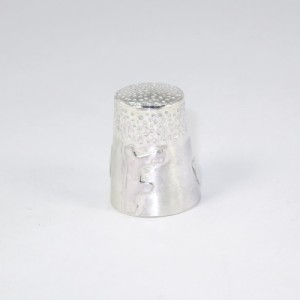
This thimble was commissioned to mark one of those ‘special’ birthdays. Apart from being a keen sempstress, the recipient also loved gardening. Hence the initial ‘F’ is meant to look like a branch and the rear has representations of leaves.
The thimble is fabricated from sheet with both bright and satin textures. I was given a thimble that fits in order to get the size right – the tricky bit. It is, of course, hallmarked.
From the giver – ‘F++++++++ is delighted with it, so thanks again for your time and work.’
From the recipient – ‘ I’m emailing to say thank you for making my lovely thimble. I’m really pleased with the design and finish. I have been using it for sewing already and it fits very well and does everything a thimble should do! So thanks again’
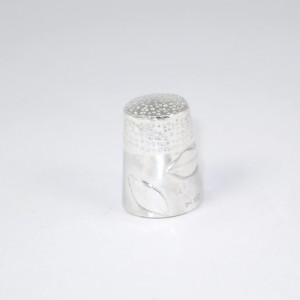
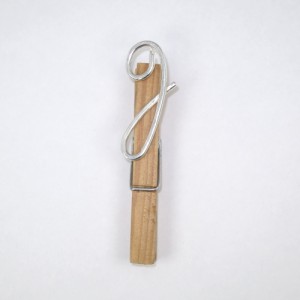
I’ve previously made a treble clef to fit into a wooden peg to clip the score on a music stand that can also be detached and used as a brooch.
I was asked to do the same as a gift, but with an initial J replacing the clef. My customer expected it to be used as a paper organiser, but the recipient likes it immensely and intends to wear it as a brooch.
As delivered, the upper bar was fixed to the lower bar with thread through the lugs. I’ve replaced this with a tube and pin fitting rather than a solid wire or small rivets on each lug.
I now have a new ring sizing machine that will be quicker and more accurate for stretching a wide range of rings and shrinking plain bands such as wedding rings.
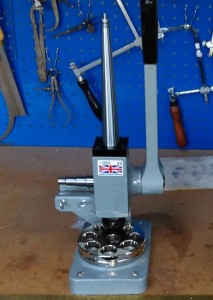
As ever, I don’t promise anything until I’ve seen the ring, but this new tool should expand my repertoire further.
If there is a price and a ![]() button then the item is available for sale. Unless you collect, deliveries will follow Royal Mail’s last posting dates of Monday 21 for items under £35 or Wednesday 23rd for other items. I need to have received the order by midday on those dates to allow for packing and transport to the Post Office.
button then the item is available for sale. Unless you collect, deliveries will follow Royal Mail’s last posting dates of Monday 21 for items under £35 or Wednesday 23rd for other items. I need to have received the order by midday on those dates to allow for packing and transport to the Post Office.
Have a good Christmas.
John
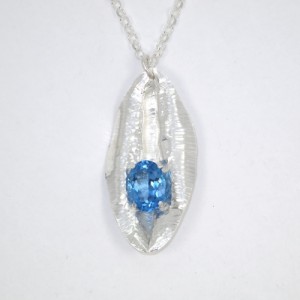
A recent commission, this pendant is a new style of work for me called fold forming. The stone is a beautiful Swiss blue topaz with a four claw setting to hold the stone in the fold. The beauty of the faceted, transparent topaz is enhanced by the silver reflecting light to and from the stone. The bulk of the metal is fine silver, but because of the chain, it is hallmarked as sterling.
I shall be doing more work using this technique which will end up in my shop in due course.
A recent commission has been a matching set of napkin rings for a special event. To remind the owners of the time they walked the Thames path, the napkins each have a representation of the Thames Path from Lechlade to Walton.
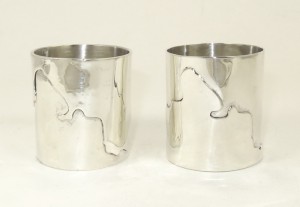
What you see on the left is the north bank formed from an extra layer of silver, whilst on the right hand side the south bank is thicker using the other part of the silver sheet – economical on silver! Hence the napkins are a sort of ‘half a sixpence’. The section of the path seen here is from Oxford at the top and Reading at the bottom, with Radley in the middle. The rings are deeper than normal to accomodate the route without compression. They are hallmarked and engraved on the insided.